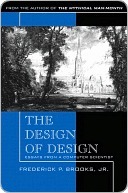More on this book
Community
Kindle Notes & Highlights
Read between
August 24, 2021 - April 22, 2024
For most human makers of things, the incompletenesses and inconsistencies of our ideas become clear only during implementation. Thus it is that writing, experimentation, “working out,” are essential disciplines for the theoretician.
great designs have conceptual integrity—unity, economy, clarity.
Detailing will of course surface conflicting versions of the Concept and force resolution.
Then, slowly, I came to realize that the most useful service I was performing for my client was helping him decide what he really wanted.
A chief service of a designer is helping clients discover what they want designed.
The most potent reason to study design history is to learn what doesn’t work, and why.
One can often get something for nothing, if one has previously bought nothing for something.
In short, as one ponders the trade-offs, there comes a new understanding of the whole design problem as an intricately interlocked interplay of factors. With it comes a change in the weightings of the desiderata. The same thing happens as the client, if there is one, grows his understanding of what he will get and develops his detailed vision of how he will use it.
Even if the goal were fixed and known, all the desiderata enumerated, the design tree known precisely, and the goodness function precisely defined, design would still be iterative, because the constraints keep changing.
It is important to list the known constraints explicitly at the start of the design process, as part of what architects call the design program


